


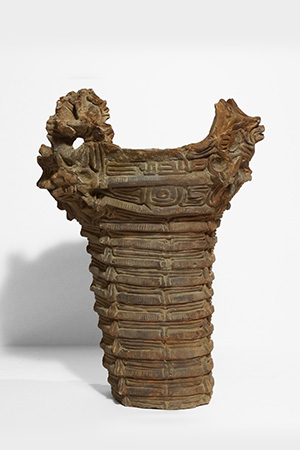
朝日貝塚出土の縄文式土器(レプリカ)
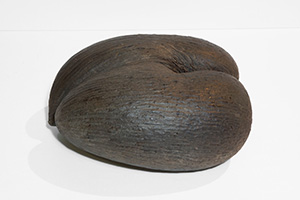
オオミヤシの種子
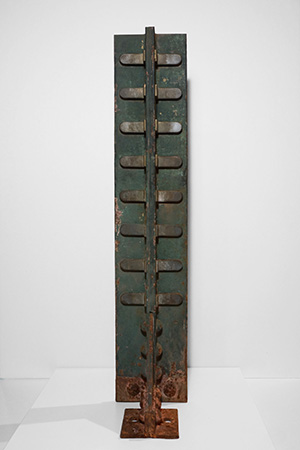
煉瓦倉庫の書架支柱
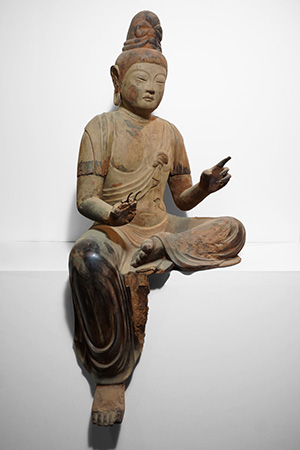
脱活乾漆技法研究制作品
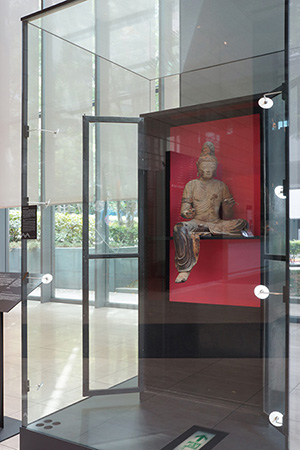
脱活乾漆技法研究制作品の展示風景

モバイルミュージアム(赤坂インターシティ)
展示標本 (2013.8.5〜2014.1.31)
小ケース1:朝日貝塚出土の縄文式土器(レプリカ)
縄文式土器の中でも優品として知られている土器の一つ。北陸地方の代表的な縄文時代貝塚遺跡の一つ、富山県朝日貝塚から、1925年に柴田常惠らの調査によって出土したとされている。土器形式としては、縄文時代中期の「上山田式」に分類され、上部の文様のアクセントと胴部の螺旋状の繰り返し隆起線が特徴的、「籠」形に成形されたとされている。(2228, A1506)
Jomon pottery from Asahi shell mounds, Toyama prefecture (replica) A Jomon pottery piece known for its characteristic form and ornamentation. It is thought to have been recovered by archeologist Jokei Shibata and colleagues in 1925, at Asahi shell mound, one of the well-known Jomon sites of the Hokuriku region. It belongs to the Middle Jomon period, and is characterized by accentuated form and design towards the top and spiraling repetitive ornamentation throughout the body. It has been described as “basket-like” in form. (2228, A1506)
小ケース2:オオミヤシの種子
オオミヤシ(別名フタゴヤシ、ウミヤシ)はインド洋の西側に位置するセーシェル諸島特産のヤシ科植物。雌雄異株の高木で、樹高は約30メートルにも達し、長さ7メートルの巨大な扇型の葉をつける。世界最大の種子をつける植物として知られ、種子(植物学的には核果)の大きさは50cm、重さは30キロにも達する。果実は受粉してから成熟するまで約6年かかり、さらに発芽するまでに3年を要する。巨大な葉は屋根葺き用に、種子は置物や中身をくりぬいて容器としても利用されていたが、現在大きな群落はプララン島のヴァレ・ド・メ自然保護区とキュリーズ島のみに残り、厳重に保全されている。(標本番号なし)
Seed of Coco de Mer (Lodoicea maldivica (J.F. Gmel.) Pers.)
Lodoicea maldivica, “Coco de Mer”is a palm endemic to the Seychelles, an archipelago in the Indian Ocean. The species has female and male flowers on separate trees. The trees reach 30 m in height and bear large rigid fan-like leaves to 7 m long. The fruit is bilobed and globose and up to 50 cm long. At 30 kg, it is the largest seed among plants. The fruit requires 6 years to mature and a further 3 years to germinate. The large leaves have been used for the roofs of houses, and the seeds have been cut to use as stationary containers. Large populations are distributed only in the Vallée de Mai Nature Reserve “May Valley” on Praslin Island and on Curieuse Island. Coco de Mer is now strictly conserved.
小ケース3:煉瓦倉庫の書架支柱
東京大学の赤門横の煉瓦倉庫で使用されていた書架の鋼製支柱である。この煉瓦倉庫は1916(大正5)年2月に史料編纂掛の耐火書庫として建設されたもので、1923(大正12)年の関東大震災を生き延びた貴重な歴史遺産である。この倉庫の2階には造り付けの鉄骨骨組に欅板張りの書架が残されており、標本はその支柱部分を切り出したものである。2 つのL型鋼を組み合わせて柱とし、棚板を受ける支持金具は真鍮製としている。煉瓦倉庫は2012年4月にオープンした伊藤国際学術研究センターでレストランとして再生され、書架は2013年3月にオープンしたミュージアム「インターメディアテク」の展示用什器として再利用されている。(標本番号なし)
Post from the book stacks of the brick warehouse
A steel post from the book stacks of the brick warehouse built beside the Red Gate (Akamon) of the University of Tokyo. The warehouse was completed in February of 1916 as a fireproof book storage facility by the Historiographical Institute of the University. This historically important building survived the Great Kanto Earthquake of 1923. The steel-frame and Japanese Zelkova book stacks were located on the second floor of the warehouse. The post consists of two steel angles with brass brackets that supported the shelving. The brick warehouse was renovated and in April of 2012 became the restaurant of the Ito International Research Center. In March of 2013 the book stacks were re-used as exhibition fixtures for the new 'Intermediatheque' museum.
中ケース:脱活乾漆技法研究制作品
奈良時代に最も多く用いられた脱活乾漆技法は、麻布を漆で貼り重ねて固めた張り子のような形状が特徴である。像を支えるための心木と呼ばれる木彫の骨組みを挿入しているが、大部分は空洞である。そのため、木彫による仏像と比較しても重量を軽く作る事が可能であり、火災などの場合にも持ち出す事が出来たとも推測される。高価な漆の使用量が多いため平安時代以降は衰退してしまうが、東アジア諸国において日本ほど多くの乾漆仏が現存するのは珍しく、文化が大切に伝わり続けた結果とも言える。(標本番号なし)
Research Study Based on the Hollow-Core Dry-Lacquer Technique
In the hollow-core dry-lacquer (dakkatsu kanshitsu) technique of sculpture, most widely used in the Nara period, layers of hemp cloth soaked with lacquer are superimposed and hardened to form a piece similar in structure to the papier-mâché. In order to sustain the sculpture, a wooden frame is inserted in the core, but most of the sculpture is hollow. That is why this type of sculpture is much lighter than the woodcrafted Buddhist sculptures. We suppose that it allowed them to be carried away easily in case of fire. Because it consumes a considerable amount of expensive lacquer, this technique declined after the Heian period. Nonetheless, few East Asian countries still possess as many kanshitsu Buddhist sculptures as Japan, and this can be seen as the result of a proper transmission of culture.
解説文執筆
諏訪 元 (本館教授、形態人類学)
西野 嘉章 (本館館長・教授、美術史学、博物館工学)
郄山 浩司 (本館特任助教、植物系統進化学)
菊池 敏正 (本館特任助教、文化財保存学)
写真撮影
松本 文夫 (本館特任准教授、建築学)
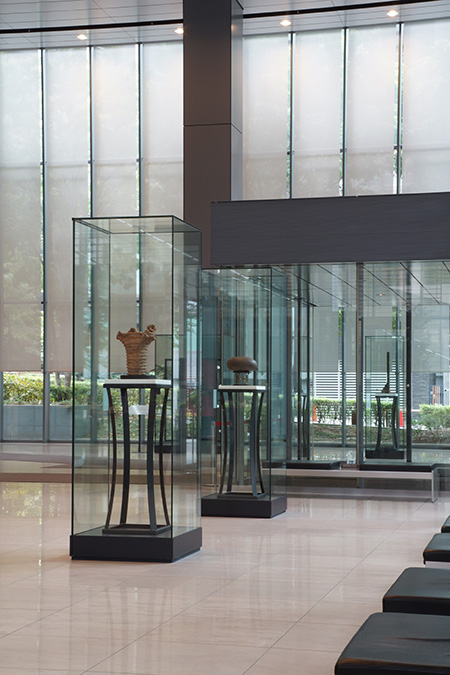
モバイルミュージアムの展示
他の展示期間の展示物
2007年1月〜2007年7月
2007年7月〜2008年2月
2008年2月〜2008年8月
2008年8月〜2009年2月
2009年2月〜2009年7月
2009年8月〜2010年1月
2010年2月〜2010年7月
2010年8月〜2011年1月
2011年1月〜2011年7月
2011年8月〜2012年1月
2012年1月〜2012年7月
2012年8月〜2013年2月
2013年2月〜2013年8月
2013年8月〜2014年1月
2014年2月〜2014年11月
2014年11月〜2015年7月
2015年8月〜2016年1月
2016年2月〜2016年7月
今までのトップページの連続スライドショー
新日鉄興和不動産本社におけるモバイルミュージアム(非公開)
ページの先頭に戻る